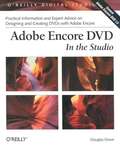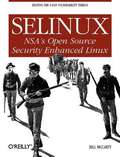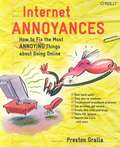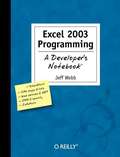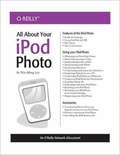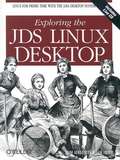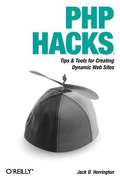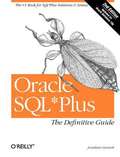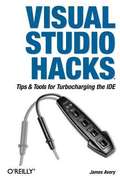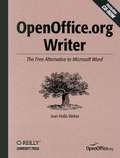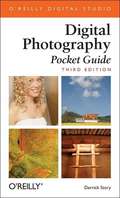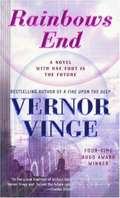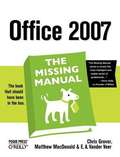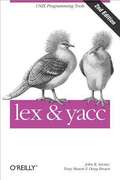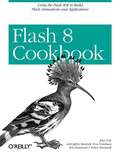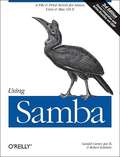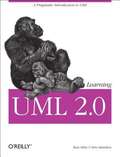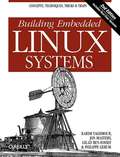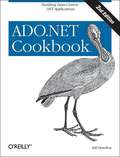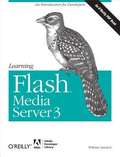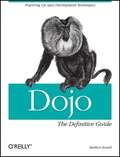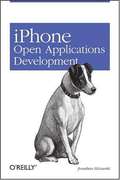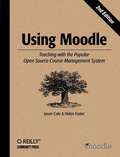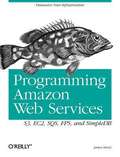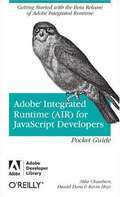- Table View
- List View
Adobe Encore DVD: In the Studio
by Doug DixonIf you're looking for an easy and stimulating way to master Adobe Encore DVD and fine-tune your moviemaking skills at the same time, look no further than Adobe Encore DVD: In the Studio . This full-color tutorial will help you push the limits of Adobe Encore DVD by helping you to create highly imaginative designs and projects. Designed primarily for Adobe Creative Suite developers, particularly those using Adobe Premiere and AfterEffects, as well as filmmakers who wish to transfer their projects to DVDs, the book combines practical learning materials and project-based lessons. But Adobe Encore DVD: In the Studio is not your average tutorial. The book draws on the experience of author Doug Dixon--an expert on Adobe Encore DVD, the author of other books on DVD development, and a core member of the product's alpha and beta programs. Well-versed in both the use and design of Adobe Encore DVD, Dixon imbues this O'Reilly Media digital book with the unique perspective of an insider who really knows his pixels. Adobe Encore DVD: In the Studio discusses the protocols involved with DVD files and file systems; pixel aspect ratio issues; common gotchas using both still and motion media; and a plethora of tips and tricks to using dynamic buttons. You'll get up to speed on importing from Photoshop and AfterEffects, making motion video menus available, and looping video and audio. You'll also learn about adding multilingual menus and subtitles, encoding rules, scripting, and even placing Easter eggs in a DVD! By studying this comprehensive, hands-on tutorial, you will be able to quickly and efficiently develop professional-looking DVDs studded with special effects worthy of a Hollywood studio.
SELinux
by Bill MccartyThe intensive search for a more secure operating system has often left everyday, production computers far behind their experimental, research cousins. Now SELinux (Security Enhanced Linux) dramatically changes this. This best-known and most respected security-related extension to Linux embodies the key advances of the security field. Better yet, SELinux is available in widespread and popular distributions of the Linux operating system--including for Debian, Fedora, Gentoo, Red Hat Enterprise Linux, and SUSE--all of it free and open source. SELinux emerged from research by the National Security Agency and implements classic strong-security measures such as role-based access controls, mandatory access controls, and fine-grained transitions and privilege escalation following the principle of least privilege. It compensates for the inevitable buffer overflows and other weaknesses in applications by isolating them and preventing flaws in one application from spreading to others. The scenarios that cause the most cyber-damage these days--when someone gets a toe-hold on a computer through a vulnerability in a local networked application, such as a Web server, and parlays that toe-hold into pervasive control over the computer system--are prevented on a properly administered SELinux system. The key, of course, lies in the words "properly administered." A system administrator for SELinux needs a wide range of knowledge, such as the principles behind the system, how to assign different privileges to different groups of users, how to change policies to accommodate new software, and how to log and track what is going on. And this is where SELinux is invaluable. Author Bill McCarty, a security consultant who has briefed numerous government agencies, incorporates his intensive research into SELinux into this small but information-packed book. Topics include: A readable and concrete explanation of SELinux concepts and the SELinux security model Installation instructions for numerous distributions Basic system and user administration A detailed dissection of the SELinux policy language Examples and guidelines for altering and adding policies With SELinux , a high-security computer is within reach of any system administrator. If you want an effective means of securing your Linux system--and who doesn't?--this book provides the means.
Internet Annoyances
by Preston GrallaWhat began as an intrepid U.S. Government initiative in the early 1970's has turned into a global way of life. Indeed, with more than 500 million current users (and counting), the Internet has revolutionized the way societies function the world over. From dating and shopping online, to conducting informational research, to communicating via email, today seemingly everyone uses the Internet for one purpose or another. How, then, can something so vast and powerful be defiled by something as trivial as spam? It's true. The fact remains that despite the leading-edge technological sophistication fueling the Net, there are still many related annoyances that complicate and tarnish the Internet experience. And it doesn't matter if you're a homemaker in search of a fresh chicken recipe, or a civil engineer researching plans for a new skyscraper, the problems are the same. Internet Annoyances understands the universal nature of the Internet and strives to make its use as stress-free as possible. This insightful guide shows you how to overcome the most annoying Internet-related quirks, bugs, and hassles. You'll learn how to make a seamless connection, thwart would-be hackers, ensure greater security while surfing, eliminate pop-up ads, maximize online services, conduct more effective Google searches, better utilize digital media (music and video), and much more. In addition, Internet Annoyances discusses how to design and host a personal web site something once thought of as only possible for the technically gifted. Topics like blogs, domain names, setup, HTML, fonts, and graphics and are all dissected and analyzed for easy consumption. Unlike other books on the subject, Internet Annoyances assumes readers already possess a working knowledge of the Internet. By fully recognizing the experience level of today's Internet culture, author Preston Galla is able to cut immediately to the chase and not waste time on the more obvious points. Internet Annoyances , therefore, is a quick read that presents succinct solutions for the many glitches that still populate the Internet experience.
Excel 2003 Programming: A Developer's Notebook
by Jeff WebbOn the surface, it doesn't appear as if much in Excel 2003 has changed. There are a handful of new objects and the user interface is largely the same. But beyond a superficial glance, you'll see that there are fundamental shifts implied by the new features: Lists, XML, web services, .NET, and InfoPath build a framework for entirely new ways to exchange data with Excel. In fact, that's much of what Excel 2003 is all about--solving problems that deal with teamwork-- collecting and sharing data, programming across applications, and maintaining security. The latest in our Developer's Notebook series, this guide introduces intermediate to advanced Excel VBA programmers to the newest programming features of Excel 2003,--focusing just on what's new--so you can get up to speed quickly. Light on theory and long on practical application, the book takes you directly to the topics you'll want to master through a series of hands-on projects. With dozens of practical labs, you'll be able to decide for yourself which new aspects of Excel will be useful or not in your own work. And best of all, you won't have to buy an expensive revision of a legacy Excel programming tutorial to learn about the new features--if they're covered there at all. Excel 2003 Programming: A Developer's Notebook shows you how to work with lists and XML data, secure Excel applications, use Visual Studio Tools for Office, consume Web Services, and collect data with Infopath. Each chapter is organized into a collection of labs, each of which addresses a specific programming problem. You can follow along to complete the lab on your own, or jump ahead and use the samples the author has built for you. The new Developer's Notebooks series from O'Reilly covers important new tools for software developers. Emphasizing example over explanation and practice over theory, they focus on learning by doing--you'll get the goods straight from the masters, in an informal and code-intensive style that suits developers. If you've been curious about Excel 2003, but haven't known where to start, this no-fluff, lab-style guide is the solution.
All About Your iPod Photo
by Wei-Meng LeeApple has recently released the iPod photo, a fourth generation (4G) iPod capable of displaying color photos. With its new enhanced color screen, you can now do more than ever with your iPod--it's no longer just a music player. If you are the proud owner of the new iPod photo you'll be eager to know all the cool things are that you can do with your new toy. This eDoc includes many useful tips and tricks for using your iPod photo. "All About Your iPod Photo" covers all of the features of this exciting new device, detailed instructions on how to use the iPod photo, and a section on the most useful accessories available. From synchronizing your iPod with iPhoto, to using your iPod to give presentations, to podcasting, just about anything you can do with the iPod photo is covered. "All About Your iPod Photo" is a must-have document for owners of Apple's latest entry in the iPod line.
Exploring the JDS Linux Desktop
by Tom Adelstein Sam HiserThe Java Desktop System (TM), from Sun Microsystems, is a modern system for all kinds of users, novice through expert. As an unusually robust, well-integrated desktop system, it may become the first to fulfill the promise of mass adoption for open source. JDS brings Linux and other open source software up to a level of usability that makes them suitable for the enormous base of Personal Computer users including office workers, students, mobile and home users. It behaves pretty much the way a Windows or Mac user would expect, but with many more powerful features. JDS has seen widespread adoption in the United States, Britain, China, and elsewhere. This book is the ideal guide to JDS: it is clear and direct, but loaded with insights from authors who have spent time working with, supporting, and enhancing the system. Tom Adelstein is an award winning polymath system designer; Sam Hiser is a respected business consultant with an itch that led him to become the marketing project lead for OpenOffice.org. Both are advocates for open source and founders of the Open Government Interoperability Project, members of the Open Source Software Institute and contributors to the JDShelp.org project. This book carefully covers such housekeeping chores as setting up networking, updates, and backups. Then it enters into great depth concerning the key productivity tools every user needs: email, web browsing, instant messaging, word processing, spreadsheets, and slide presentations. A number of chapters and appendices concerning useful tools, including things you can add to your system, rounds out this remarkably useful book. It has plenty to offer the new user as well as the seasoned Linux professional.
PHP Hacks
by Jack HerringtonProgrammers love its flexibility and speed; designers love its accessibility and convenience. When it comes to creating web sites, the PHP scripting language is truly a red-hot property. In fact, PHP is currently used on more than 19 million web sites, surpassing Microsoft's ASP .NET technology in popularity. Not surprisingly, this surge in usage has resulted in a number of PHP books hitting the market. Only one, though, takes the language beyond traditional Web programming and into mapping, graphing, multimedia, and beyond: PHP Hacks . In PHP Hacks , author Jack Herrington wrings out his 20 years of code generation experience to deliver hands-on tools ranging from basic PHP and PEAR installation and scripting to advanced multimedia and database optimizing tricks. On the practical side of things, PHP Hacks helps you develop more robust PHP applications by explaining how to improve your database design, automate application testing, and employ design patterns in your PHP scripts and classes. In the category of "cool," Herrington explains how to upgrade your Web interface through the creation of tabs, stickies, popups, and calendars. He even examines how to leverage maps and graphics in PHP. There's also a bounty of image and application hacks, including those that show you how to: Integrate web sites with Google maps and satellite imaging Dynamically display iPhoto libraries online Add IRC, SMS, and Instant Messaging capabilities to your Web applications Drop the latest Wikipedia dictionary onto your Sony PSP Render graphics and user interfaces with SVG, DHTML, and Ajax Whether you're a newcomer or an expert, you'll find great value in PHP Hacks , the only PHP guide that offers something useful and fun for everyone.
Oracle SQL*Plus: The Definitive Guide, 2nd Edition
by Jonathan GennickDespite its wide availability and usage, few developers and DBAs have mastered the true power of Oracle SQL*Plus. This bestselling book--now updated for Oracle 10g--is the only in-depth guide to this interactive query tool for writing SQL scripts. It's an essential resource for any Oracle user. The new second edition of Oracle SQL*Plus: The Definitive Guide clearly describes how to perform, step-by-step, all of the tasks that Oracle developers and DBAs want to perform with SQL*Plus--and maybe some you didn't realize you could perform. With Oracle SQL*Plus: The Definitive Guide , you'll expertly: write and execute script files generate ad hoc reports extract data from the database query the data dictionary tables customize an SQL*Plus environment and much more It also includes a handy quick reference to all of its syntax options and an often-requested chapter on SQL itself, along with a clear, concise, and complete introduction. This book is truly the definitive guide to SQL*Plus. It's an indispensable resource for those who are new to SQL*Plus, a task-oriented learning tool for those who are already using it, and an immediately useful quick reference for every user. If you want to leverage the full power and flexibility of this popular Oracle tool, you'll need this book.
Visual Studio Hacks
by James AveryWith start-up templates for projects ranging from Windows applications to web services, and extensive help and on-line documentation, Visual Studio .NET might be mistaken for a tool for unsophisticated users. It's true that most developers soon discover that the basic operation of Visual Studio is fairly self-explanatory; less obvious are some of the suite's more advanced built-in features. Visual Studio .Net includes a wealth of little-used capabilities, is very customizable, has a complete automation model, and much more. On top of its regular feature set, there are hosts of free add-ins, macros, and power toys that can further enhance the functionality of Visual Studio. This book is all about exploring these things, and in doing so, becoming a better and more efficient developer. Developers will learn how to: Get the most out of projects and solutions, including getting down and dirty with the undocumented format of project and solution files Use these editor features to the fullest, and add additional functionality to the editor through the use of third-party add-ins Learn smarter ways to navigate the application and your own source code Customize shortcut keys, toolbars, menus, the toolbox, and much more Use the debugger successfully not only on your source code, but with T-SQL and scripting languages as well Automatically generate code Learn how the server can be used to interface with databases, services, and performance counters, as well as WMI Use and create Visual Studio add-ins to extend its functionality Offering valuable tips, tools, and tricks, Visual Studio Hacks takes you far beyond the suite's usual capabilities. You can read this book from cover to cover or, because each hack stands its own, you can feel free to browse and jump to the different sections that interest you most. If there's a prerequisite you need to know about, a cross-reference will guide you to the right hack. If you want to experience the full spectrum of Visual Studio's functionality and flexibility, you'll find the perfect guide for exploration in Visual Studio Hacks . Once the final page is turned, you can confidently say that you've been exposed to everything that Visual Studio .NET is capable of doing.
OpenOffice.org Writer
by Jean Hollis WeberThanks to OpenOffice.org, there is an alternative to Microsoft Word. If you've ever been frustrated by Word's quirks and limitations--including its price tag--and longed for a practical alternative, then it's time to break free. OpenOffice.org is the free, open source office suite and its word processor, Writer, has proven extremely popular with both Windows and Linux users. How good can it be if it's free? you might ask. And how much trouble will it be to install and learn? A quick tour of the program will show you: the features you use regularly--from formatting and spell check to using templates and creating indexes --are all there. And Writer's intuitive, surprisingly familiar interface lets you navigate with ease. To quickly master the ins and outs of Writer, you'll want a copy of OpenOffice.org Writer: The Free Alternative to Microsoft Word . This handy reference is packed with essential information to help you learn the basics of Writer and become adept with its advanced features. Written for intermediate and advanced users of word processing programs, OpenOffice.org Writer: The Free Alternative to Microsoft Word provides guidance for common and advanced word processing tasks. With this book, you'll learn how to: Set up OOoWriter to work your way Write, edit, and review documents Control page layout Use templates and styles effectively Get the most from using fields Work with Tables of contents, indexes, bibliographies Manage large or complex documents Insert, edit and create graphics Make a smooth transition from Microsoft Word OpenOffice.org Writer: The Free Alternative to Microsoft Word provides guidance for anyone who wants to break out of the Word rut. Its detailed Table of Contents make it a handy reference for even the most experienced word processing users who want to get up to speed quickly with this program, or make sure they're taking full advantage of OOo Writer's features. With the complete office suite included on a CD (which you can install on as many machines as you like), this book makes using Writer an easy decision. OpenOffice.org Writer: The Free Alternative to Microsoft Word is part of the O'Reilly Community Press Series. Unlike classic O'Reilly animal books, O'Reilly's role in the series is limited to providing manufacturing and distribution services rather than editorial development, so that each Community Press title reflects the editorial voice and organization of the community that has created it.
Digital Photography Pocket Guide, 3rd Edition
by Derrick StoryEven film diehards have a tough time resisting the instant gratification of the digital camera. Today's digital cameras are more affordable then ever before, and they deliver high quality images that are a snap to share. Plus, you can take risks with a digital camera you never would with a film camera. You waste nothing; there's no film required, and because you only print the pictures you need, digital photography is cost effective and environmentally friendly. But to take full advantage of a digital camera, you need to be an experienced photographer and an expert at digital photography too. With more than 15 years of experience as a photojournalist, author Derrick Story brings you Digital Photography Pocket Guide , 3rd Edition. For everyone who owns or will own a digital camera (and that pretty much means everyone!), this is the perfect on-the-go guide for taking top-notch digital photos. In this third edition of the bestselling pocket guide, Story expands on the basic photography techniques that he introduced in earlier editions, including an explanation of each camera component and what it does, tips for choosing just the right settings for your needs, and much more. This indispensable guide covers everything from how to shoot sports action, close ups, and night shots, to dealing with image resolution, archiving, and memory cards. Affordable and portable, Digital Photography Pocket Guide , 3rd Edition offers full-color photographs, screen shots, and line art illustrating all the topics in the guide's three main sections ("Digital Camera Components," "Standard Camera Functions," and "How Do I?"). Contents are labeled A to Z for quick reference. There's also a comprehensive table of contents and index so you'll waste no time flipping to the specific information you need--whether you want to transfer images, make a QuickTime movie, or just figure out what purpose that mystery setting on your camera serves. There's even a section of easy-to-read reference tables for quick look-up of white balance settings, exposure compensation, camera mode explanations, and plenty more.
Rainbows End
by Vernor VingeFour time Hugo Award winner Vernor Vinge has taken readers to the depths of space and into the far future in his bestselling novels A Fire Upon the Deep and A Deepness in the Sky. Now, he has written a science-fiction thriller set in a place and time as exciting and strange as any far-future world: San Diego, California, 2025.<P><P> Robert Gu is a recovering Alzheimer's patient. The world that he remembers was much as we know it today. Now, as he regains his faculties through a cure developed during the years of his near-fatal decline, he discovers that the world has changed and so has his place in it. He was a world-renowned poet. Now he is seventy-five years old, though by a medical miracle he looks much younger, and he's starting over, for the first time unsure of his poetic gifts. Living with his son's family, he has no choice but to learn how to cope with a new information age in which the virtual and the real are a seamless continuum, layers of reality built on digital views seen by a single person or millions, depending on your choice. But the consensus reality of the digital world is available only if, like his thirteen-year-old granddaughter Miri, you know how to wear your wireless access -- through nodes designed into smart clothes -- and to see the digital context -- through smart contact lenses.<P> With knowledge comes risk. When Robert begins to re-train at Fairmont High, learning with other older people what is second nature to Miri and other teens at school, he unwittingly becomes part of a wide-ranging conspiracy to use technology as a tool for world domination.<P> In a world where every computer chip has Homeland Security built-in, this conspiracy is something that baffles even the most sophisticated security analysts, including Robert's son and daughter-in law, two top people in the U.S. military. And even Miri, in her attempts to protect her grandfather, may be entangled in the plot.<P> As Robert becomes more deeply involved in conspiracy, he is shocked to learn of a radical change planned for the UCSD Geisel Library; all the books there, and worldwide, would cease to physically exist. He and his fellow re-trainees feel compelled to join protests against the change. With forces around the world converging on San Diego, both the conspiracy and the protest climax in a spectacular moment as unique and satisfying as it is unexpected. This is science fiction at its very best, by a master storyteller at his peak.<P> Hugo Award winner.
Office 2007: The Missing Manual
by Matthew Macdonald Chris Grover E. A. Vander VeerQuickly learn the most useful features of Microsoft Office 2007 with our easy to read four-in-one guide. This fast-paced book gives you the basics of Word, Excel, PowerPoint and Access so you can start using the new versions of these major Office applications right away. Unlike every previous version, Office 2007 offers a completely redesigned user interface for each program. Microsoft has replaced the familiar menus with a new tabbed toolbar (or "ribbon"), and added other features such as "live preview" that lets you see exactly what each option will look like in the document before you choose it. This is good news for longtime users who never knew about some amazing Office features because they were hidden among cluttered and outdated menus. Adapting to the new format is going to be a shock -- especially if you're a longtime user. That's where Office 2007: The Missing Manual comes in. Rather than present a lot of arcane detail, this quick and friendly primer teaches you how to work with the most-used Office features, with four separate sections covering the four programs. The book offers a walkthrough of Microsoft's redesigned Office user interface before taking you through the basics of creating text documents, spreadsheets, presentations, and databases with: Clear explanations Step-by-step instructions Lots of illustrations Plenty of friendly advice It's a great way to master all 4 programs without having to stock up on a shelf-load of different books. This book has everything you need to get you up to speed fast. Office 2007: The Missing Manual is truly the book that should have been in the box.
lex & yacc, 2nd Edition
by John R. Levine Tony Mason Doug BrownThis book shows you how to use two Unix utilities, lex and yacc, in program development. These tools help programmers build compilers and interpreters, but they also have a wider range of applications. The second edition contains completely revised tutorial sections for novice users and reference sections for advanced users. This edition is twice the size of the first and has an expanded index. The following material has been added: *Each utility is explained in a chapter that covers basic usage and simple, stand-alone applications *How to implement a full SQL grammar, with full sample code *Major MS-DOS and Unix versions of lex and yacc are explored in depth, including AT&T lex and yacc , Berkeley yacc, Berkeley/GNU Flex, GNU Bison, MKS lex and yacc, and Abraxas PCYACC.
Flash 8 Cookbook
by Joey LottThis practical, nuts-and-bolts toolkit puts theory into practice with ready-made answers to common Flash development questions. It's the perfect resource for Flash developers, as well as designers who are ready to start doing development work. Flash 8 Cookbook offers quick look-up (and cross-referenced) recipes in four main categories: Creating Flash Content Building Interactive Flash Interfaces Adding Multimedia and Data Planning Flash Projects Using O'Reilly's popular Problem/Solution/Discussion Cookbook format, this book offers 280 standalone recipes that include a brief explanation of how and why the solution works, so you can adapt it to similar situations you may run across in the future. For people who say, "I understand everything in theory, but I don't know where to start in practice," this book offers ready-to-use answers to real-world problems. Joey Lott is the author of ActionScript Cookbook (O'Reilly) and co-author of Flash MX 2004 ActionScript Bible (Wiley). He's a leading speaker and consultant in the Flash development community.
Using Samba, 3rd Edition
by Robert Eckstein Jay Ts Gerald CarterThis book is the comprehensive guide to Samba administration, officially adopted by the Samba Team. Wondering how to integrate Samba's authentication with that of a Windows domain? How to get Samba to serve Microsoft Dfs shares? How to share files on Mac OS X? These and a dozen other issues of interest to system administrators are covered. A whole chapter is dedicated to troubleshooting! The range of this book knows few bounds. Using Samba takes you from basic installation and configuration -- on both the client and server side, for a wide range of systems -- to subtle details of security, cross-platform compatibility, and resource discovery that make the difference between whether users see the folder they expect or a cryptic error message. Integration with Active Directory and OpenLDAP Migrating from Windows NT 4.0 domains to Samba Delegating administrative tasks to non-root users Central printer management Advanced file serving features, such as making use of Virtual File System (VFS) plugins. Samba is a cross-platform triumph: robust, flexible and fast, it turns a Unix or Linux system into a file and print server for Microsoft Windows network clients. This book will help you make your file and print sharing as powerful and efficient as possible. The authors delve into the internals of the Windows activities and protocols to an unprecedented degree, explaining the strengths and weaknesses of each feature in Windows domains and in Samba itself. Whether you're playing on your personal computer or an enterprise network, on one note or a full three-octave range, Using Samba will give you an efficient and secure server. The current edition covers such advanced 3.x features as:
Learning UML 2.0
by Russell Miles Kim Hamilton"Since its original introduction in 1997, the Unified Modeling Language has revolutionized software development. Every integrated software development environment in the world--open-source, standards-based, and proprietary--now supports UML and, more importantly, the model-driven approach to software development. This makes learning the newest UML standard, UML 2.0, critical for all software developers--and there isn't a better choice than this clear, step-by-step guide to learning the language." --Richard Mark Soley, Chairman and CEO, OMG If you're like most software developers, you're building systems that are increasingly complex. Whether you're creating a desktop application or an enterprise system, complexity is the big hairy monster you must manage. The Unified Modeling Language (UML) helps you manage this complexity. Whether you're looking to use UML as a blueprint language, a sketch tool, or as a programming language, this book will give you the need-to-know information on how to apply UML to your project. While there are plenty of books available that describe UML, Learning UML 2.0 will show you how to use it. Topics covered include: Capturing your system's requirements in your model to help you ensure that your designs meet your users' needs Modeling the parts of your system and their relationships Modeling how the parts of your system work together to meet your system's requirements Modeling how your system moves into the real world, capturing how your system will be deployed Engaging and accessible, this book shows you how to use UML to craft and communicate your project's design. Russ Miles and Kim Hamilton have written a pragmatic introduction to UML based on hard-earned practice, not theory. Regardless of the software process or methodology you use, this book is the one source you need to get up and running with UML 2.0. Additional information including exercises can be found at www.learninguml2.com . Russ Miles is a software engineer for General Dynamics UK, where he works with Java and Distributed Systems, although his passion at the moment is Aspect Orientation and, in particular, AspectJ. Kim Hamilton is a senior software engineer at Northrop Grumman, where she's designed and implemented a variety of systems including web applications and distributed systems, with frequent detours into algorithms development.
Building Embedded Linux Systems
by Karim Yaghmour Jonathan Masters Gilad Ben-YossefThere's a great deal of excitement surrounding the use of Linux in embedded systems -- for everything from cell phones to car ABS systems and water-filtration plants -- but not a lot of practical information. Building Embedded Linux Systems offers an in-depth, hard-core guide to putting together embedded systems based on Linux. Updated for the latest version of the Linux kernel, this new edition gives you the basics of building embedded Linux systems, along with the configuration, setup, and use of more than 40 different open source and free software packages in common use. The book also looks at the strengths and weaknesses of using Linux in an embedded system, plus a discussion of licensing issues, and an introduction to real-time, with a discussion of real-time options for Linux. This indispensable book features arcane and previously undocumented procedures for: Building your own GNU development toolchain Using an efficient embedded development framework Selecting, configuring, building, and installing a target-specific kernel Creating a complete target root filesystem Setting up, manipulating, and using solid-state storage devices Installing and configuring a bootloader for the target Cross-compiling a slew of utilities and packages Debugging your embedded system using a plethora of tools and techniques Using the uClibc, BusyBox, U-Boot, OpenSSH, thttpd, tftp, strace, and gdb packages By presenting how to build the operating system components from pristine sources and how to find more documentation or help, Building Embedded Linux Systems greatly simplifies the task of keeping complete control over your embedded operating system.
ADO.NET 3.5 Cookbook, 2nd Edition
by Bill HamiltonThis guide is strikingly different from other books on Microsoft ADO.NET. Rather than load you down with theory, the new edition of ADO.NET 3.5 Cookbook gives you more than 200 coding solutions and best practices for real problems you're likely to face with this technology using Visual Studio 2008 and the .NET 3.5 platform. Organized to help you find the topic and specific recipe you need quickly and easily, this book is more than just a handy compilation of cut-and-paste C# code. ADO.NET 3.5 Cookbook also offers clear explanations of how and why each code solution works, and warns you of potential pitfalls so you can learn to adapt the book's problem-solving techniques to different situations. This collection of timesaving recipes covers vital topics including: Connecting to data Retrieving and managing data Transforming and analyzing data Modifying data Binding data to .NET user interfaces Optimizing .NET data access Enumerating and maintaining database objects Maintaining database integrity Ideal for ADO.NET programmers at all levels, from the relatively inexperienced to the most sophisticated, this new edition covers the significant 3.5 upgrade, including new programming tools such as LINQ. ADO.NET 3.5 Cookbook offers a painless way for those of you who prefer to learn by doing when it comes to expanding your skills and productivity.
Learning Flash Media Server 3
by William B. SandersIf you're interested in recording and streaming media using Flash Media Server 3 (FMS3) and Adobe's Real-Time Messaging Protocol, this unique 267-page PDF-only book is the perfect primer. It is not a reference, but a systematic guide to developing FMS3 applications using ActionScript 3.0, with chapters that focus on specific aspects of the server and how they work. FMS3 is very different from regular web servers. Because its open-socket server technology stays connected until users quit the application, you can stream audio, video, text, and other media in real time. FMS3 is also quite different from previous versions, a fact that web developers familiar with Flash Media Server 2 or Flash Communication Server 1.5 will quickly discover. Don't worry. With Learning Flash Media Server 3 and a little experience with Flash CS3 and ActionScript 3.0, anyone can get up to speed in no time. You'll learn how to install FMS3, organize your development environment with Apache web server, and use the management console before diving into the whys and hows of: Recording and playing back streaming audio and video in VP6 and H.264 formats Using the new Flash Media Encoder to stream and record video Camera and microphone settings Non-persistent client-side remote shared objects Two-way audio-video communications Broadcasting and server-side bandwidth control Working with server-side files: the file class Server-side shared objects Server-side streams Setting up a software load handler using FMS3's new server-side NetStream Bringing in data and working with configuration files At the heart of every chapter is a core set of code that shows the minimum requirements needed for different procedures. Beyond that, Learning Flash Media Server 3 provides you with plenty of options for using FMS3's different versions -- the full-feature server, the streaming-only server, and the limited-user development server. It's a whole new world of media, and this book puts you right at the doorstep. Ready to enter?
Dojo: The Definitive Guide
by Matthew RussellOf all the Ajax-specific frameworks that have popped up in recent years, one clearly stands out as the industrial strength solution. Dojo is not just another JavaScript toolkit -- it's the JavaScript toolkit -- and Dojo: The Definitive Guide demonstrates how to tame Dojo's extensive library of utilities so that you can build rich and responsive web applications like never before. Dojo founder Alex Russell gives a foreword that explains the "why" of Dojo and of this book. Dojo provides an end-to-end solution for development in the browser, including everything from the core JavaScript library and turnkey widgets to build tools and a testing framework. Its vibrant open source community keeps adding to Dojo's arsenal, and this book provides an ideal companion to Dojo's official documentation. Dojo: the Definitive Guide gives you the most thorough overview of this toolkit available, showing you everything from how to create complex layouts and form controls closely resembling those found in the most advanced desktop applications with stock widgets, to advanced JavaScript idioms to AJAX and advanced communication transports. With this definitive reference you get: Get a concise introduction to Dojo that's good for all 1.x versions Well-explained examples, with scores of tested code samples, that let you see Dojo in action A comprehensive reference to Dojo's standard JavaScript library (including fundamental utilities in Base, Dojo's tiny but powerful kernel) that you'll wonder how you ever lived without An extensive look at additional Core features, such as animations, drag-and-drop, back-button handling, animations like wipe and slide, and more Exhaustive coverage of out-of-the-box Dijits (Dojo widgets) as well as definitive coverage on how to create your own, either from scratch or building on existing ones An itemized inventory of DojoX subprojects, the build tools, and the DOH, Dojo's unit-testing framework that you can use with Dojo -- or anywhere else If you're a DHTML-toting web developer, you need to read this book -- whether you're a one-person operation or part of an organization employing scores of developers. Dojo packs the standard JavaScript library you've always wanted, and Dojo: The Definitive Guide helps you transform your ideas into working applications quickly by leveraging design concepts you already know.
iPhone Open Application Development
by Jonathan A. ZdziarskiCertain technologies bring out everyone's hidden geek, and iPhone did the moment it was released. Even though Apple created iPhone as a closed device, tens of thousands of developers bought them with the express purpose of designing and running third-party software. In this clear and concise book, veteran hacker Jonathan Zdziarski -- one of the original hackers of the iPhone -- explains the iPhone's native environment and how you can build software for this device using its Objective-C, C, and C++ development frameworks. iPhone Open Application Development walks you through the iPhone's native development environment, offers an overview of the Objective-C language you'll use with it, and supplies background for the iPhone operating system. You also get detailed recipes and working examples for everyone's favorite iPhone features -- graphics and audio programming, interfaces for adding multitouch functionality to games, the use of hardware sensors, and the device's vast user interface kit. This book explains: How to access the iPhone's underlying operating system The makeup of an iPhone application How to get the open source tool chain running on your desktop The iPhone's core user interface framework, which is heavily tied to major application-level functions Using the many touted iPhone features such as multitouch, hardware sensors, and gestures Intercepting and handling event notifications for many iPhone-related events Raw video surfaces and 3D transformations that take you deeper into advanced graphics on the iPhone How to record and play simple sounds and intercept sound events Advanced digital audio output using Apple's new Audio Toolbox framework Advanced user interface components such as section lists, keyboards, and image manipulation The Appendix includes a compendium of miscellaneous code examples for cool application features, such as using the camera and creating a CoverFlow®-like album browser. This book is a true hacker's book, designed for the millions of users who have run third party applications on their iPhone, but its concepts and code examples have shown to be remarkably similar to Apple's official SDK, making this book a valuable resource for both camps. Any programmer can use this book to write applications with the same spectacular effects that made the device an immediate hit, and impress users just as much as the official iPhone software does. That programmer can easily be you.
Using Moodle, 2nd Edition
by Jason Cole Helen FosterUsing Moodle is a complete, hands-on guide for instructors learning how to use Moodle, the popular course management system (CMS) that enables remote web-based learning and supplements traditional classroom learning. Updated for the latest version, this new edition explains exactly how Moodle works by offering plenty of examples, screenshots and best practices for its many features and plug-in modules. Moodle gives teachers and trainers a powerful set of web-based tools for a flexible array of activities, including assignments, forums, journals, quizzes, surveys, chat rooms, and workshops. This book is not just a how-to manual. Every chapter includes suggestions and case studies for using Moodle effectively. By itself, Moodle won't make your course better. Only by applying effective educational practices can you truly leverage its power. With this book, you will: Get a complete overview CMS in general and Moodle in particular. Review Moodle's basic interface and learn to start a course. Learn to add Moodle tools to your course, and how different tools allow you to give quizzes and assignments, write journals, create pathed lessons, collaboratively develop documents, and record student grades. Discover some of the creative ways teachers have used Moodle. There are plenty of ideas for effectively using each tool. Effectively manage your Moodle course, such as adding and removing users, and creating user groups. Learn to use Moodle's built-in survey functions for assessing your class. Find out how to administer an entire Moodle site. A system administrator usually handles these functions, but if you're on your own, there's a lot of power behind the curtain. Using Moodle is both a guide and a reference manual for this incredibly powerful and flexible CMS. Authored by the Moodle community, this authoritative book also exposes little known but powerful hacks for more technically savvy users, and includes coverage of blogs, RSS, databases, and more. For anyone who is using, or thinking of using, this CMS, Using Moodle is required reading.
Programming Amazon Web Services
by James MurtyBuilding on the success of its storefront and fulfillment services, Amazon now allows businesses to "rent" computing power, data storage and bandwidth on its vast network platform. This book demonstrates how developers working with small- to mid-sized companies can take advantage of Amazon Web Services (AWS) such as the Simple Storage Service (S3), Elastic Compute Cloud (EC2), Simple Queue Service (SQS), Flexible Payments Service (FPS), and SimpleDB to build web-scale business applications. With AWS, Amazon offers a new paradigm for IT infrastructure: use what you need, as you need it, and pay as you go. Programming Amazon Web Services explains how you can access Amazon's open APIs to store and run applications, rather than spend precious time and resources building your own. With this book, you'll learn all the technical details you need to: Store and retrieve any amount of data using application servers, unlimited data storage, and bandwidth with the Amazon S3 service Buy computing time using Amazon EC2's interface to requisition machines, load them with an application environment, manage access permissions, and run your image using as many or few systems as needed Use Amazon's web-scale messaging infrastructure to store messages as they travel between computers with Amazon SQS Leverage the Amazon FPS service to structure payment instructions and allow the movement of money between any two entities, humans or computers Create and store multiple data sets, query your data easily, and return the results using Amazon SimpleDB. Scale up or down at a moment's notice, using these services to employ as much time and space as you need Whether you're starting a new online business, need to ramp up existing services, or require an offsite backup for your home, Programming Amazon Web Services gives you the background and the practical knowledge you need to start using AWS. Other books explain how to build web services. This book teaches businesses how to take make use of existing services from an established technology leader.
Adobe Integrated Runtime (AIR) for JavaScript Developers Pocket Guide
by Mike Chambers Daniel Dura Kevin HoytWritten by members of the Adobe Integrated Runtime (AIR) product team, this is the official guide to the beta release of Adobe's new cross-platform desktop runtime, previously known by its code name Apollo. This book explains how you can use AIR to build and deploy HTML and JavaScript-based web applications to the desktop, using all of the tools and technologies with which you are already familiar. Everything you need to know about this platform is right here, so you can start building applications with AIR right away. Topics include: What AIR is, and the problems this runtime aims to solve How to set up your development environment How to create your first app using HTML and JavaScript The HTML and JavaScript environments within AIR How to do common tasks, presented in the easy-to-use O'Reilly Cookbook format Also included is a guide to AIR packages, classes and command line tools. Once you understand the basics of building an HTML- and JavaScript-based AIR applications, this pocket guide makes an ideal reference for tackling specific problems. Welcome to the revolution! Adobe Developer Library is a co-publishing partnership between O'Reilly Media and Adobe Systems, Inc. and is designed to produce the number one information resources for developers who use Adobe technologies. Created in 2006, the Adobe Developer Library is the official source for comprehensive learning solutions to help developers create expressive and interactive web applications that can reach virtually anyone on any platform. With top-notch books and innovative online resources covering the latest in rich Internet application development, the Adobe Developer Library offers expert training and in-depth resources, straight from the source.
